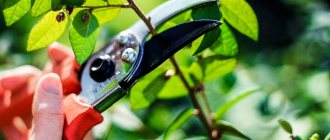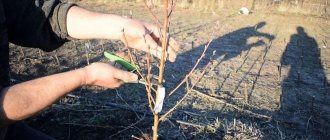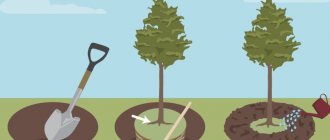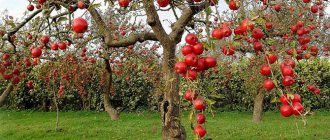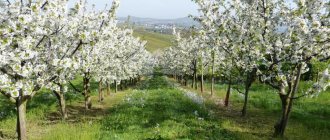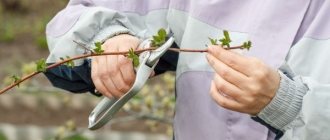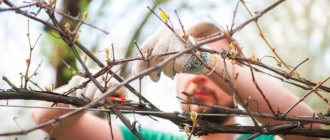Timing for spring pruning of fruit trees
The optimal time for pruning fruit trees is slightly frosty days with temperatures in the range from 0 to +5 degrees, since at too low temperatures the tree may not tolerate cold weather, and if the work is done after the sap begins to flow, it will hurt for a long time and is unlikely to enjoy abundant harvest.
Therefore, it is so important not to miss the period when pruning will be the least traumatic and will only bring benefits.
In central Russia, the removal of unnecessary shoots is usually carried out from about 2-3 weeks of March until April 10-15.
Pruning of trees and fruit-bearing bushes is carried out for the first time immediately after planting the seedlings. It consists in shortening the central trunk (trunk).
The purpose of the procedure in this case is to stimulate the low formation of branches on the tree, on which fruits will subsequently grow.
In the future, pruning is carried out annually in the spring, this allows you to restrain the growth of the tree, control its development and reduce the likelihood of the formation of a dense crown and competing shoots.
In what cases is sleeping possible?
The reasons for cutting down or cutting down trees are different and you can read about them in this article Why trees are cut down.
Thinning is rarely used on trees located on private lands; in addition, they must be carried out by a qualified forester , otherwise, instead of benefit, this operation will only bring harm.
Therefore, the most common reasons are:
- interference with some work;
- changing the purpose of the site;
- danger created by the tree.
If a tree interferes with some work , but it is impossible to legally remove it without obtaining permission, then its cutting can be initiated either by the owner of the site during the preparation of documents for the upcoming work, or by the contractor during the execution of the work.
In any case, you must first submit documents, including a work plan and justification for the need to remove the tree, then pay for the examination and the costs of restoring the ecological balance. The same situation arises when the purpose of a land plot changes.
With emergency and dangerous trees, everything is somewhat different. After all, you first need to prove that the plant poses a danger and the only way to solve the problem is to cut it down or cut it down. Moreover, the check will be carried out taking into account the value of the plant, its age and other factors. Therefore, before submitting an application, you must clearly understand what signs allow you to classify a tree as dangerous or dangerous.
When is tree pruning contraindicated?
You should not focus only on the average timing of agrotechnical measures.
The pruning time is chosen not depending on the month, but primarily based on weather conditions.
If work is carried out in early spring on too frosty days, this can lead to stunting and death of the crop.
In addition, unthawed branches are very fragile, so cutting them accurately is basically impossible. Branch cuts in cold weather turn out uneven and unsightly.
On the other hand, shortening and sawing off shoots after the onset of heat also does not give anything good, since the plants quickly come to life at this time.
Therefore, if the weather gets warmer too suddenly and too early, then it is better to postpone pruning garden trees until the fall.
Where to go to cut down a tree?
It is impossible to say unequivocally where to go to cut down a tree, because everything depends on who will :
- initiate the process;
- collect a package of documents;
- issue a permit or logging ticket;
- perform work.
We have prepared several action algorithms taking into account various situations.
The owner of the site independently prepares all documents
This is the most difficult, but at the same time the cheapest method, in which the following procedure must be followed: the owner of the site contacts the local administration through a single window with a request to recognize the tree as a nuisance and remove it.
Then it receives a list of required documents, including :
- passport;
- papers confirming the ownership of the site;
- a statement detailing the reasons why the plant should be removed;
- design documentation for changing the site;
- an agreement with the contractor company (required only for cutting down the interfering plant);
- receipts for payment of fees for damage caused to nature.
Having submitted the entire package of documents, he receives a permit or a felling ticket, after which he pays for the services of an arborist.
Documents for the customer - an individual are drawn up by the contractor
The owner of the house turns to the contractor, who independently prepares all the permits, so the customer only has to make payment.
In this case , the customer is spared the need to collect a package of documents , and therefore provides the contractor with the same basic documents as described in the previous section if it is planned to remove a non-emergency plant.
In the case of an emergency facility, the contractor independently issues a permit or a felling ticket, but the cost of his services turns out to be noticeably higher.
Documents are submitted by a legal entity
The procedure is the same as for an individual.
A representative of the organization contacts the relevant administration department to conduct an examination and provides an initial package of documents, which is in many ways similar to the package for individuals.
After the inspection and the commission meeting, as well as its positive decision, the representative independently issues a permit/felling ticket or entrusts this work to the contractor.
Crown options
The crown of fruit trees and shrubs performs several functions. Firstly, it limits the further growth of the plant and accordingly enhances the formation of fruits, and secondly, it helps to grow reinforced branches that can easily withstand the weight of fruits and berries.
The crown can be shaped in different ways during pruning.
Basically, experienced gardeners use 4 pruning schemes.
Longline
When choosing a tiered branch resolution, the tree retains its natural appearance. The tiered form of crown trimming is similar to a pyramid, pointed upward.
Vertical
For development and growth during pruning, skeletal branches are left, located almost horizontally in relation to the trunk.
Fusiform
The shoots are sawed off so that the crown of the tree is formed in the form of an oval. The spindle-shaped pruning pattern is applicable for stone fruit crops - plums, apricots, cherries.
Cup-shaped
During pruning, the central trunk is shortened, and a bowl is formed from the skeletal side branches.
This crown is more suitable for trees that are particularly difficult to care for, such as peach.
There are many other options for forming crowns, but usually they begin to be used on their site after achieving sufficient experience in pruning trees.
Types of seasonal pruning in spring
There are 4 main types of pruning.
Formative
It is used to form the crown, due to which nutrients are correctly distributed throughout the tree, and the shoots grow strong and healthy.
Formative pruning gives the plant a decorative appearance and improves fruit development. It is carried out until the tree reaches 4-5 years of age.
Rejuvenating
It is used on already old plants. When carrying out rejuvenating pruning, the oldest branches are removed, which activates the formation of new shoots.
Recommended after the tree or shrub reaches 3 years of age. In the future, pruning for the purpose of rejuvenation is done at least once every 4 years.
Reducing growth
Redirects plant resources from the formation and development of new branches to the formation of large, tasty and juicy fruits. It is advisable to reduce the growth of garden crops by pruning in the first 4 years after planting.
Sanitary
It is carried out not only in spring, but also at any other time. Dry, non-viable shoots and those branches that grow inside the formed crown are subjected to sanitary sawing.
All types of pruning are mainly aimed at increasing the penetration of sunlight to the tree, strengthening nutrition and immunity, that is, those processes that increase the yield and quality of fruits.
What happens if you cut down a tree or trim branches yourself?
For pruning branches (uprooting a plant), as well as for cutting down a tree without permits, administrative penalties are provided.
According to clause 8.6.10 of the order of the Ministry of Regional Development of Russia dated December 27, 2011 No. 613 “On approval of methodological recommendations for the development of norms and rules for the improvement of municipal territories,” the violator is obliged to compensate for damage in the amount of the cost of the tree. In the capital, according to Art. 4.19 of the Code of Administrative Offenses of Moscow, the fine for destroying a tree ranges from 4,000 to 4,500 rubles.
Technological features of pruning
Cutting off shoots from fruit-bearing trees has been used for centuries, and today there are 4 main agrotechnical pruning techniques:
- On the kidney. Allows you to direct growing branches in the direction desired by the gardener. On a one-year-old branch, a bud is found looking in this direction, the pruning shears are placed a little higher and the shoot is cut off at an angle of 45 degrees.
- On the ring. This technique helps to remove weakened branches, as a result, nutrients are spent on the development of those shoots that will ultimately produce a harvest. The pruning is carried out shallowly along the annular bead, but so that no stump remains.
- For side branching. This technique redistributes the plant’s resources from one branch to another, more promising one, that is, it stimulates the development of fruiting shoots.
All agrotechnical pruning techniques reduce the overall load on the bush and increase the penetration of sunlight into the leaves and crowns.
Rules for pruning trees - steps, stages, diagrams
Pruning fruit crops makes sense only if it is carried out constantly.
Trees over 10 years old are in greater need of sanitary and regulatory procedures; a rejuvenating technique can also be applied to them.
Beginner gardeners should be guided by the following rules when pruning trees:
- First of all, diseased and dried shoots and branches that grow towards the inside of the bush are removed.
- Bare branches are also subjected to cuttings, since they still won’t produce a harvest.
- Skeletal shoots are removed only if they interfere with the growth and development of more fruitful shoots.
- Shoots extending from the trunk, the length of which exceeds 3 meters, must be shortened.
- The tops, the non-fruit-bearing shoots extended upward, are completely cut out.
Nuances of pruning
Failure to comply with pruning deadlines is one of the common mistakes of novice gardeners, but in order for the agrotechnical measure to be beneficial and not harm the plants, a number of other nuances are also taken into account.
Selecting and preparing the appropriate tool
Branches are pruned with pruning shears, loppers, and saws. The tools must be well sharpened before pruning, otherwise you will not be able to cut off the shoots accurately, and this will lead to unnecessary injury to the tree.
The quality of sharpening improves if, before carrying out sharpening, the devices are soaked in a salty solution at the rate of a tablespoon of salt per glass of plain water.
Tools must be disinfected after sharpening.
Equipment for work
An important point is the choice of tools. They must be of high quality and comfortable, given that they will be used for a lot of work. So, the price of the product includes the price of the metal. Therefore, a high-quality tool cannot be cheap. Before purchasing, it is advisable to take it in your hand, raise and lower it, and make several movements simulating cutting. It's good if everything is done conveniently.
In addition, it is desirable that the product have bright plastic inserts. This will make it easier to find the lopper in the grass if it accidentally falls. A strong loop on the handle wouldn't hurt. It is worn on the wrist. This prevents the device from falling when the user's fingers accidentally open. We offer a list of necessary tools.
Garden saw
It differs from its construction counterpart in having small teeth sharpened on both sides. This allows you to make an even, high-quality cut. Under no circumstances should you use regular saws, much less chainsaws, to trim branches. After them, torn cuts may not heal for years. For ease of work, garden saws for pruning trees are available with telescopic handles or on rods. The angle of the tip is adjustable. This tool is convenient to work from the ground, sawing off an area at height.
Secateurs
Device for removing fragments up to 300 mm in diameter. When sharpened well, it gives a smooth, even cut that quickly heals. There are many types of pruning shears; gardeners often choose bypass or “anvil” ones. The first ones have curved blades. They cut accurately, but you have to apply force. The second ones have straight blades. Less effort has to be applied for cutting, but accuracy suffers a little.
Garden knife
A cutting device with a blade curved in the shape of a sickle. It must always be sharpened very sharply, otherwise it will not be possible to clean or evenly cut the wood. Sometimes it is used to cut branches, but it is better not to do this. Without the proper skills, it is easy to spoil the cut and harm the plant.
Before the procedure, you need to prepare what to treat the tree after pruning. The best option is garden var or similar compositions such as “RanNet”, “Zhivitsa”. In some recommendations you can find a technique for making such pastes with your own hands, but it is hardly worth spending time and energy on this. The composition is available in any store.
Some gardeners prefer to cover wounds with paint. This is possible, but only oil paints are chosen. They are made on the basis of drying oil. Those prepared with solvent will not work. They will not help the wound heal; on the contrary, they will worsen the situation.
Instagram semena_kokshe
Instagram garden.master.korenovsk
- Tools
6 essential tools for gardeners that will make gardening easier
Features of pruning pear trees
The pear is trimmed:
- After planting a seedling in the ground. The central trunk is lowered to approximately 80-90 cm and all shoots from the sides of the trunk are cut off.
- In the second year, the crown of young trees is formed in a tiered manner. On the pear, 3-6 skeletal branches radiating like a fan are left in each branch subordinate to the central trunk. Their height is approximately 20-25 cm lower in relation to the main conductor.
- Caring for old pears includes pruning dry, frozen and diseased branches, as well as those shoots that stretch vertically or inward and compete with the base.
In pear trees, unlike apple trees, the branches are cut to a side shoot. This is due to the fact that excessive pruning of this garden crop leads to the appearance of tops.
If it is necessary to force a branch growing upward to take a horizontal position, then it is removed, focusing on the strongest lateral bud located outside.
It can also be bent down and tied to a strong stake stuck in the soil.
This method is usually used on old pear trees with a very dense crown, since mature trees do not tolerate rejuvenating pruning well.
What is the regulation for cutting down healthy and dry trees?
In addition to laws and regulations adopted at the city or district level, there are documents that are valid throughout the country and regulate all issues related to the maintenance of green spaces.
This is what regulates the cutting of dry and healthy trees:
- Federal Law “On Environmental Protection” dated January 10, 2002 N 7-FZ.
- Order of the State Construction Committee of the Russian Federation dated December 15, 1999 N 153 “On approval of the Rules for the creation, protection and maintenance of green spaces in the cities of the Russian Federation.”
- Civil Code of the Russian Federation.
- Land Code of the Russian Federation.
- Forest Code of the Russian Federation.
- Federal Law “On the general principles of organizing local self-government in the Russian Federation” dated October 6, 2003 N 131-FZ.
- SNiP 2.07.01-89 Urban planning. Planning and development of urban and rural settlements.
These documents regulate only general issues; in addition, different interpretations are possible on many points , therefore Federal Law FZ-131 gives local authorities quite broad powers.
According to this law, it is local authorities :
- establish the procedure for recognizing a tree as unsafe or dangerous;
- determine the list of species and characteristics of trees prohibited from cutting down without obtaining permission;
- determine the list of documents required to obtain a permit;
- determine the cost of wood of a particular species, as well as the costs of restoration measures.
In addition, only representatives of the local administration have the authority to recognize a tree as dangerous, threatening or dry and decide its fate. Without their permission, in most cases, cutting down turns into an administrative and sometimes criminal offense.
Therefore, it is the legislation at the local level that regulates the cutting of healthy, emergency and dry trees, therefore each city, or even urban area, has its own regulations, which include:
- a list of species that cannot be cut down without permission;
- characteristics of a plant of any breed, after reaching which it cannot be removed without permission;
- list of documents required to obtain permission;
- a list of organizations that have the right to independently issue logging tickets or permits.
Features of spring pruning apple trees
The goal of caring for young apple trees is to obtain a symmetrical fruit-bearing crown.
Pruning is carried out immediately after planting the seedling:
- The stem is cut so that its height is 80-90 cm.
- If the seedling already has young shoots, then 3-5 of them (the strongest, strongest and directed in different directions) are cut off by approximately one third or a quarter of the length. If there are no shoots from the sides, then this procedure is carried out the next year.
- The skeletal branches are cut so that the main conductor rises approximately 25 cm above the topmost one. In this case, the lower branches should be longer than the upper ones.
During the next annual spring pruning, all damaged and dried out shoots are removed from the apple tree. The branches that thicken the crown, as well as the shoots developing inward towards the center, are also cut off.
The subordination of the branches is also assessed - the skeletal branches should not be higher in height than the main conductor.
Pruning columnar apple trees is somewhat different, since their crown is formed vertically.
How to prune raspberries in the fall to get maximum yield?
Raspberry bushes are pruned in the fall, if this could not be done after harvesting in the summer. If there are no berries on the shoots of a two-year-old raspberry, it means that the shoots have stopped developing and will dry out by autumn. In preparation for winter, cut them back to the roots. In the fall, it is advisable to predict how many young raspberry shoots you will leave for the next season. Usually about 40% of the strongest shoots are left, the rest is cut off. In the spring they are counted again.
Remontant raspberries set berries longer than usual; they can grow several harvests a year - on last year's shoots and on this year's shoots. To obtain both summer and autumn harvests, in late autumn only those parts of the branches on which the berries were planted are cut off. In cooler regions, two methods are used: pruning only two-year-old shoots or completely pruning repair raspberries. The last method is considered the best.
Features of spring pruning of young trees
Young fruit trees are pruned very carefully. It is important not to waste time - the first procedure must be carried out immediately after landing. Initial sawing is a mandatory shortening of the trunk.
In young fruit trees, pruning stimulates the growth and development of lateral branches, which will produce a harvest.
It is also necessary to monitor the height of the main conductor - it should always be higher than the side shoots.
From the first years of planting plants in the garden, the formation of the correct crown is monitored.
To do this, branches suitable for the fruit are determined, competitors are cut off, and the shoots are sawed off to the bud, so that they subsequently grow in the required direction.
Common mistakes when pruning
Starting to grow garden crops is always very difficult and mistakes in this matter cannot be avoided.
Pruning experience comes with age, but to avoid banal problems, you should listen to the advice of experienced gardeners:
- The pruning scheme for each tree and shrub is selected depending on their type, that is, on the characteristics of development and growth.
- Sawing must be done extremely carefully, as excessive damage has a negative impact on fruiting. To prevent infection and accelerate overgrowth, sections are treated with garden varnish.
- Pruning must be carried out annually, otherwise there is no point in it.
- Avoid heavy sawing and pruning with stumps, as this not only worsens the decorative appearance of the bush, but also prevents the formation of healthy fruits.
- There's no need to rush. First, with a marker or other device, mark those branches on the tree that need pruning and only then proceed directly to the procedure.
Before starting work, it wouldn’t hurt to watch videos that explain pruning rules with examples.
In many cases, information “live” is perceived much better compared to theoretical knowledge.
Why is it better to turn to professionals?
At first glance, crowning garden crops is a simple procedure that you can handle on your own. However, for an inexperienced person, there are certain risks in carrying it out: falling from a height, breaking off a heavy branch, the danger of a branch coming into contact with an electrical wire, working with a sharp tool. Therefore, if a novice gardener does not know how to prune trees correctly, it is better to seek help from arborists. These are specially trained people who master the correct pruning technique and all the necessary skills for this.
Important! In addition to the necessary knowledge and skills, professionals have all the necessary equipment. This makes pruning a quick and safe procedure in their hands.
Pruning garden trees in 2022 according to the lunar calendar
The life cycle of plants is influenced by lunar phases. This fact has been proven not only by the centuries-old experience of our ancestors, but also by the research of modern scientists.
When sawing off shoots, it is necessary for the plant to experience the least amount of stress. Pruning carried out during the waning moon is considered less traumatic for trees.
During this phase, plant juices rush down to the roots and, accordingly, the branches react weakly to external influences and heal faster after a traumatic procedure.
According to the lunar calendar for 2022, spring pruning is favorable for trees on March 5 or 6. These days are considered the most successful for fruit-bearing plants in the garden.
Is it possible to cut branches if they cause insufficient light in the room?
It is possible, but to measure the illumination of the room you need to invite employees of Rospotrebnadzor. Using a lux meter, specialists will assess the absence or lack of necessary natural light and provide a solution.
In accordance with the requirements of SanPiN 2.1.2.2645-10 “Sanitary and epidemiological requirements for living conditions in residential buildings and premises”, the coefficient of natural illumination (the amount of light from the entire sky falling into the premises) in living rooms and kitchens must be at least 0, 5% in the middle of the room. The determination of KEO is carried out by specialists from accredited laboratories with washed windows. For measurements, days with continuous clouds covering the entire sky are selected.
Question answer
Where can I go to get benches installed in my house yard?

